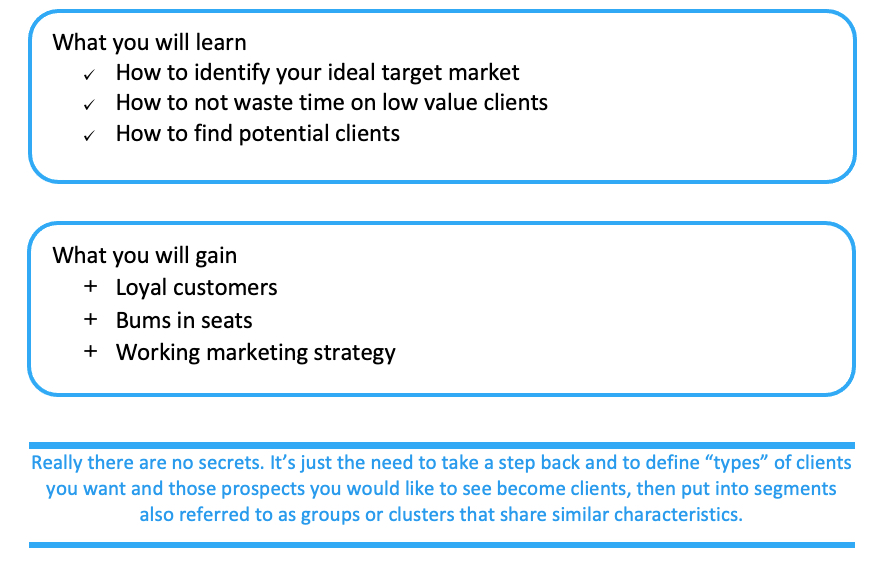THE SECRETS OF SEGMENTING

SEGMENTS
To define the segments, we determine their demographic and psychographic characteristics. This is important both for the client audience as well as the prospect audience.
Determining the demographic characteristics by identifying based on:
-
Age (under 18, 18-24, 24-32, 32-49, 50+)
-
Education (University and post grad, college, high school grad)
-
Gender (female/male split 60/40, or 70/30 or 50/50 or % LGBTQ
-
HH Income ($50,000- $100,000, $100,000 - $150,000 or $150,000 - $200,000 or $200,000+
-
Career (Senior Management (Owners, CEOs, BODs, Presidents, VP, low - mid management, blue color, professionals)
-
Married/Single
-
Family (children or no children)
-
Religion
-
Ethnicity
-
Nationality
-
Geographical location (how far will clients drive to reach your salon, this is your trading area in which to promote your salon, don’t try to attract clients further away than this geo-target)
Add determine as many of these that you can. The more defined the more the segment is defined.
Psychographic segments are a little more difficult to characterize**
-
Lifestyle choices (high society, privileged middle class, affluent, etc.)
-
Activities or interests
-
Add beliefs/ideas/opinions/thinking/views
-
Goals
-
Are they:
** The beauty of the hair industry is that it is hands-on and as you speak to your clients in the chair, you have a lot of time to ask key questions that help build their psychographic profiles.

WHY DO WE DO THIS IF IT FEELS
LIKE A LOT OF WORK FOR NOTHING?
- The reason we “cluster” is to identify the salon’s client base and potential client base and then customize/personalize messaging and ensure marketing initiatives are properly timed and directed. You would not, for example, use the same exact messages if targeting a 24 – 35 year old as you would targeting a 50 - 60 year old, nor would advertising be placed in the same media space.
-
After determining the top or largest segments which should also be those that bring in the most revenue, focus only on these segments. Now you can better allocate resources as well as establish your messaging, your content, your social advertising, your posts, your pics, etc. All communications should "speak" to these segments ONLY.
-
Do not spend time and resources marketing to other segments that may use your salon, focus only on the priority ones. Other clients may be attracted to your salon but until you see a substantial, long term benefit, stick with the top segments only.
-
At the end of this exercise, your top two segments might look like this:
-
· First client segment: age 35 – 50, mostly career in mid management, with 2 kids, married, born Canadian, interested in tennis and bridge, health and beauty conscious, priority keeping their beauty as they age, drives 30 kl to the salon.
· Second client segment: age 24-34, just starting a career, not married, wants all the latest hair trends and often displays on social media. Each visit wants to change their appearance. Walks from 2-3 kl.
Can you see how the messages would differ? Can you see if your goal was to grow your business you would be marketing to these two segments in completely different ways.
To see our complete collection
of DIY Marketing Modules